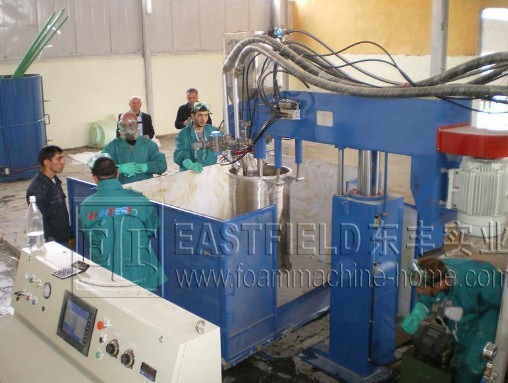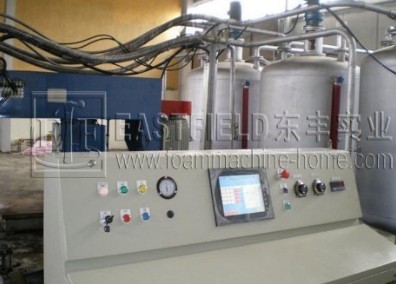| Semi-automatic Batch foaming machine
(flexible pu foam )


Model: EFBF-6II
**A semi-automatic batch foaming machine: Applications**
A semi-automatic batch foaming machine also known as A semi-automatic sponge box foaming machine is a versatile and cost-effective solution for producing sponge materials (e.g., polyurethane foam, memory foam) in controlled batches. It combines manual and automated processes, making it ideal for small-to-medium-scale production, customized foam products, or businesses transitioning from manual to fully automated systems. Below are its key applications and features:
---
**1. Core Applications**
- **Custom Foam Production**:
- Produces foam blocks or molded parts with specific shapes, densities, and hardness levels tailored to client needs.
- Suitable for prototyping, small-batch orders, or niche products.
- **Complex Shapes**:
- Creates foam components with cavities, contours, or 3D geometries (e.g., automotive seat cushions, orthopedic mattress layers).
- **Material Variety**:
- Handles diverse sponge types, including flexible PU foam, memory foam, high-resilience foam, and flame-retardant foam.
---
**2. Industry-Specific Uses**
- **Furniture Manufacturing**:
- Produces foam inserts for sofas, chairs, and mattresses, including ergonomic or contoured designs.
- **Automotive Industry**:
- Molds foam parts for car seats, armrests, headrests, and interior soundproofing panels.
- **Medical & Healthcare**:
- Fabricates medical-grade foam products like wheelchair cushions, prosthetic liners, or pressure-relief pads.
- **Packaging**:
- Creates custom-shaped foam inserts for delicate electronics, machinery, or luxury goods.
- **Consumer Goods**:
- Produces shoe soles, sports equipment padding, or household sponges.
---
**3. Key Features**
- **Semi-Automatic Operation**:
- Combines automated mixing ,some of chemicals automatic metering and automatic pouring with manual mold handling, demolding, and post-processing.
- **Adjustable Parameters**:
- Controls foam density, hardness, and curing time by adjusting chemical ratios, temperature, and pressure.
- **Mold Compatibility**:
- Works with reusable or disposable molds to create diverse shapes, from simple blocks to intricate designs.
- **Compact Design**:
- Suitable for smaller factories or workshops with limited space compared to large continuous foaming lines.
---
**4. Workflow**
1. **Mold Preparation**: The mold is manually cleaned and coated with release agents.
2. **Chemical Mixing**: Raw materials are automatically metered, mixed, and poured into the mold.
3. **Foaming & Curing**: The mixture expands to fill the mold, forming the sponge structure under controlled conditions.
4. **Demolding**: The cured foam block or part is manually removed and trimmed if needed.
5. **Post-Processing**: Foam may undergo aging, cutting, or surface treatment.
---
**5. Advantages**
- **Flexibility**:
- Easily switches between product designs by changing molds or formulations.
- **Cost-Effective**:
- Lower initial investment compared to fully automated systems, ideal for small businesses.
- **High Precision**:
- Ensures consistent quality and dimensional accuracy for molded parts.
- **Reduced Waste**:
- Minimizes material spillage compared to open foaming processes.
- **Ease of Use**:
- Requires less technical expertise than fully automated machines.
---
**6. Limitations**
- **Labor Dependency**:
- Requires manual intervention for mold handling and demolding, which can slow production.
- **Lower Output Speed**:
- Not suitable for ultra-high-volume production (e.g., mass mattress manufacturing).
- **Mold Costs**:
- Complex custom molds can be expensive to design and maintain.
---
**Summary**
The semi-automatic batch foaming machine s a practical and versatile solution for small-to-medium-scale foam production. It balances automation and manual control, offering flexibility, cost-effectiveness, and precision for customized or complex-shaped foam products. While less efficient for mass production than fully automated systems, it is an excellent choice for businesses seeking to optimize production quality and adaptability without significant upfront investment.
Foaming Process:
All the chemicals are first metered separately and then put together in the mixing tank of the machine. Then after setting the RPM and mixing time period, the chemicals are automatically poured in the mould of predefined size. Then mould is removed and the machine is washed thoroughly to make it ready for the next batch. With the help of two moulds, it is possible to make 10-12 blocks per hour depending upon the density.
The machine comes with complete know-how to produce different densities and grades of the product.
Technical data
Foaming method memoried and controled by frequency adjustment & touch screen
1. Mixing Barrel: 180 KG
2. Mixing Motor: 15HP
3. Machine Dimension: L 23M x W 3M
4. Electric Control Panel
5. Square Mold
6. PPG 4ton Tank X2
8. TDI 3ton Tank X 1
9. MC 2ton Tank X 1
10. Imported Valve X 5
11. Imported Pump X 4
12. Cooler and Heater System

﹛﹛﹛﹛﹛﹛﹛﹛﹛﹛﹛Material Tanks
|


